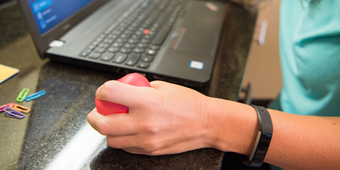Keeping Your Spunk During Breast Cancer Treatment

Find Your Perfect Match
Answer a few questions and we'll provide you with a list of primary care providers that best fit your needs.
You may be in the fight of your life, but you don’t have to look like it. By taking care of your body, you can keep looking good during and after breast cancer treatment. And you’ll likely feel better, too.
When you’re fatigued, you may not want to keep up with your regular grooming habits. But this is the time to pamper yourself!
Resources To Feel And Look Your Best
 There are lots of resources to help you during treatment and recovery.
There are lots of resources to help you during treatment and recovery.
One service, called Expressions of Hope, aims to help you look your best.
If you have a mastectomy or lumpectomy, you’ll want a bra that restores your figure. As a certified mastectomy fitter with Expressions of Hope, Melinda Prokop can help to ensure you look good and feel good post-surgery. Available by appointment, she’ll use her expertise to provide private, personalized service. She can help you find comfortable:
- Bras (with pockets) in lots of sizes and colors
- Breast prostheses
- Shapers (full and partial)
- Swimsuit breast forms
- Compression garments
Most bras and breast forms available through Expressions of Hope are covered by health insurance. If you have limited financial resources to pay for uncovered expenses, our partnership with charitable foundations may provide the funds you need. Please ask if you think you might qualify.
You can reach Melinda at 937-438-7355 to set up an appointment at any of these locations:
- Atrium Medical Center
- Miami Valley North
- Miami Valley South (includes chemotherapy beanies and lymphedema compression garments)
- Upper Valley Medical Center
Healthy Skin Care Advice
As you may already have found, chemotherapy and radiation can dehydrate your skin, making it more sensitive to sun and wind. It’s important to follow a good skin care regimen to prevent infection from entering dry, cracked skin.
To keep your skin healthy and supple, remember the four essential steps to healthy skin care:
- Cleansing
- Exfoliation
- Moisturizing
- Protection (against sun and elements)
All-natural lotions, deodorants, and sunscreens without fragrance are ideal, especially if you become sensitive to smells during treatment. Look for natural products without metals, which will be less likely to irritate your skin.
Be sure to protect your skin with a sunscreen with an SPF of 30 or higher.
Healthy Nail Care Advice
Chemotherapy may change how your nails look. Nails can become discolored or lines may appear. They also might separate from the nail bed. These changes usually go away in about six months.
In the meantime, you can protect your nails by:
- Keeping them short and neatly trimmed
- Wearing gloves when doing household chores that use cleaning agents
- Moisturizing your nails (and hands) frequently
Painting your nails can make you feel good about your appearance, but be sure to use colors that are safe. The American Cancer Society says to use a water-based nail polish and gentle, water-based polish removers.
Nail health is a key way to prevent lymphedema, a condition that causes your arm(s) to swell from fluid build-up. Lymphedema is linked to infections that can enter your body through the nail bed.
Life After Breast Cancer Treatment
Treatments for breast cancer can knock down the strongest of women — but only for a while. Keep in mind:
- Proper nutrition and exercise can energize you and boost your desire to return to everyday activities.
- Gentle massages can ease soreness and help you relax.
- As you begin to recover, your hair will regrow, although it may be different than it was before.
- Your nails will get stronger again.
- You will begin to feel more like you.
As you move beyond your breast cancer diagnosis and treatment, remember to continue to pamper yourself and take care of your mind and body.
Find Your Perfect Match
Answer a few questions and we'll provide you with a list of primary care providers that best fit your needs.
Source: Melinda Prokop, Certified Mastectomy Fitter; BreastCancer.org; American Cancer Society




